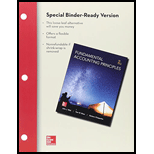
Concept explainers
Concept Introduction
Contingent Liabilities: Contingent liabilities are the potential obligations that arise due to uncertain future events which are based on (or arises from) past transactions or events. There are mainly three terms of likelihood that are used for the accounting treatment of contingent liabilities. These terms of likelihood are probable, reasonably possible and remote. ‘Virtually certain’ and ‘Remote’ are the two opposite ends of a likelihood scale. The contingent liabilities are treated in three ways in accounting as follows:
a. A
b. A contingent liability is described in notes to the financial statements if it is reasonably possible that a loss (or a future event) will occur, or if it is probable that a loss (or a future event) will occur but the company cannot reasonably estimate the amount of loss.
c. A contingent liability is neither recorded in the financial statements nor disclosed in notes to the financial statements if the probability (or likelihood) of the occurrence of the loss (or future event) is remote.
To Identify: The accounting treatment for each given claim as either (a) a liability that is recorded or (b) an item described in notes to its financial statements.
Given Info:
The following legal claims exist for Huprey Co.:
1. Huprey is a defendant in a pending lawsuit and estimates that it could result in damages of $1,250,000 and it is reasonably possible (which is a term of likelihood) that the plaintiff will win the case.
2. It is probable (which is a term of likelihood) for Huprey to face a loss on a pending lawsuit will occur but the amount of loss is not reasonably estimable.
3. It is highly probable that Huprey will lose a case and damages in the case are estimated at $3,500,000.
Want to see the full answer?
Check out a sample textbook solution
Chapter 11 Solutions
Loose Leaf for Fundamentals of Accounting Principles and Connect Access Card
- Given the solution and accountingarrow_forwardCan you explain the correct methodology to solve this general accounting problem?arrow_forwardRadiant Logic Ltd. has net sales of $295,000, cost of goods sold of $190,000, selling expenses of $18,000, and non-operating expenses of $7,500. What is the company's gross profit?arrow_forward

 AccountingAccountingISBN:9781337272094Author:WARREN, Carl S., Reeve, James M., Duchac, Jonathan E.Publisher:Cengage Learning,
AccountingAccountingISBN:9781337272094Author:WARREN, Carl S., Reeve, James M., Duchac, Jonathan E.Publisher:Cengage Learning, Accounting Information SystemsAccountingISBN:9781337619202Author:Hall, James A.Publisher:Cengage Learning,
Accounting Information SystemsAccountingISBN:9781337619202Author:Hall, James A.Publisher:Cengage Learning, Horngren's Cost Accounting: A Managerial Emphasis...AccountingISBN:9780134475585Author:Srikant M. Datar, Madhav V. RajanPublisher:PEARSON
Horngren's Cost Accounting: A Managerial Emphasis...AccountingISBN:9780134475585Author:Srikant M. Datar, Madhav V. RajanPublisher:PEARSON Intermediate AccountingAccountingISBN:9781259722660Author:J. David Spiceland, Mark W. Nelson, Wayne M ThomasPublisher:McGraw-Hill Education
Intermediate AccountingAccountingISBN:9781259722660Author:J. David Spiceland, Mark W. Nelson, Wayne M ThomasPublisher:McGraw-Hill Education Financial and Managerial AccountingAccountingISBN:9781259726705Author:John J Wild, Ken W. Shaw, Barbara Chiappetta Fundamental Accounting PrinciplesPublisher:McGraw-Hill Education
Financial and Managerial AccountingAccountingISBN:9781259726705Author:John J Wild, Ken W. Shaw, Barbara Chiappetta Fundamental Accounting PrinciplesPublisher:McGraw-Hill Education





